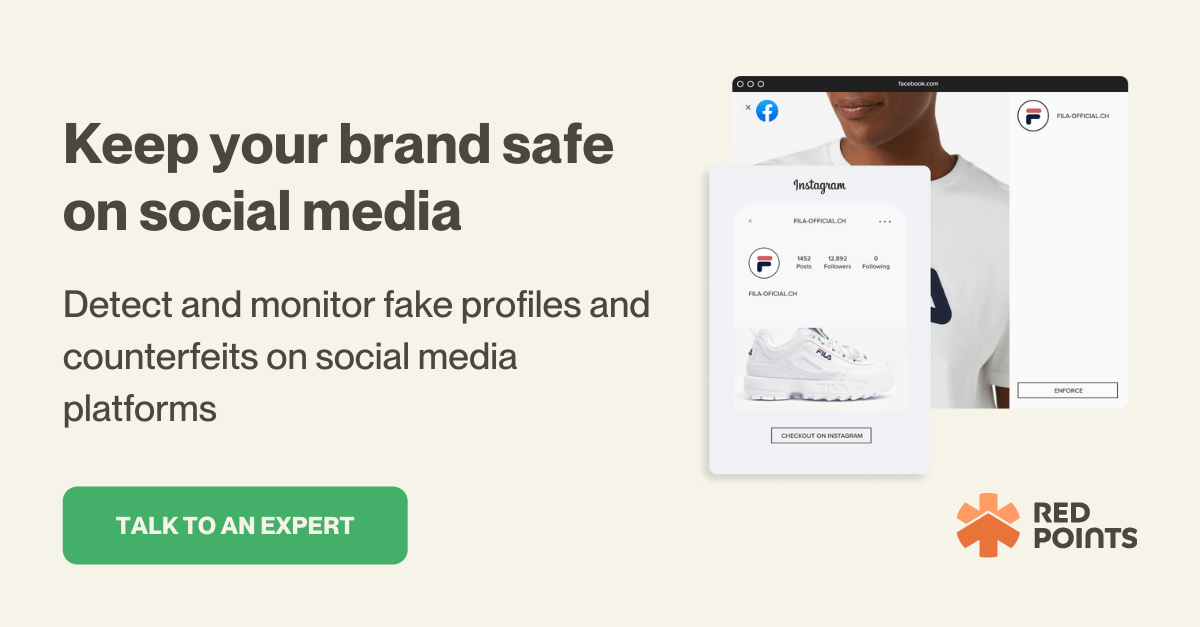
Table of Contents:
Last updated on: September 20, 2023
With social media becoming a core part of every business’ strategy, it is no secret that monitoring and protecting an organization’s IP portfolio on these platforms is critical. However, this can be a difficult task even with the best resources and one made even more challenging by the sheer volume of platforms on which to find and identify infringements.
It is not just about the volume of infringements either. With the rise of social media and the prevalence of counterfeits, brands are seeing their revenue suffer from lost sales, reputational damage and even costs associated with increased customer contacts.
As social media and ecommerce platforms increasingly integrate marketplace-like features, brands must implement a strong strategy to monitor these channels and mitigate the risks posed by bad actors.
To explore this idea, we have identified six trends that every general counsel should have in mind so as to better monitor and prevent infringement on social media in 2023.
Today, most social media platforms process payments within their own platform or redirect users to other marketplaces or websites. In many ways, the social media environment has become a more sophisticated and complex network of interwoven features, links and navigation prompts. This presents opportunities for bad actors.
Fraudsters have found many ways to hijack users’ social media journey and redirect them to fraudulent listings on marketplaces or rogue websites via false advertising.
In fact, a WIPO report showed that 5,516 cases related to cybersquatting (fake websites copying the names of actual domains) were filed in 2022, an increase of 10% from 2021.
Another report by the Federal Trade Commission (FTC) suggests that the spike in social media originated fraud has directly hit brands’ revenue. FTC data also showed around $770 million of consumer losses related to social media-originated fraud in 2021. More than 95,000 people reported losing money to social media scams that year (indicating an 18-fold rise in social media fraud since 2017), a number that looks set to increase in years to come.
While platforms are doing plenty to solve these problems, the underlying issues show no signs of going away. So, how can brands respond to these challenges?
The use of technology can be a great start. Leveraging advanced keyword-based rules that search for infringements across social media platforms in several languages and process thousands of results daily can be a real game changer. Other strategies, such as image recognition, can also allow businesses to go the extra mile by taking down counterfeits that do not infringe on their trademarks – a technique often used by bad actors on social media to go under the radar.
A few years back, social media was used primarily for networking. Today, these platforms are some of the most visited websites in the world and have grown into diverse ecosystems that help promote businesses and offer marketplaces to buy and sell goods.
Facebook, Instagram, Twitter, Pinterest and even TikTok have capitalised on this development by introducing social commerce to their channels as a new way for people to trade. The trend of these sites partnering with ecommerce businesses such as Shopify and creating internal systems like Facebook Marketplace (which has over a billion users) demonstrates how social media platforms are not just a way of discovering products but also of making transactions.
However, this shift has also presented vulnerabilities. With so many eyes on platforms like TikTok, which can boast over 800 million combined downloads from Google Play and the Apple App Store, it is no wonder that fraudsters have taken notice. In recent years, online shopping scams have flourished on social media – especially during the pandemic. Bogus vendors appear across social sites and apps, copying logos, artwork and brand messaging to eat away businesses’ profits with fraudulent listings and posts.

Brand impersonation is rife on social media. Impersonators will imitate a brand’s giveaways, websites, support agents, executives and employees to ensnare unwitting social media scrollers. In the first half of 2022 alone, there were more than 425,000 credential phishing attacks in which a brand was impersonated.
The rapid rise in these attacks is alarming. Impersonations of brands and executives on social media have grown more than 250% year on year. Armed with the analytics available on many social media sites today, scammers can be even more precise with their impersonation schemes (eg, targeted campaigns with paid ads), which are extremely complex to monitor.
Indeed, the ease and low cost at which impersonators can operate is deeply concerning. Twitter Blue’s recent implementation has also led to an increase in fake profiles on the platform, reopening the debate over the risk of social media brand impersonation and its direct impact on brands’ revenue. What is clear is that if brands fail to monitor their presence on social media sites, they will leave themselves exposed to impersonators who have the potential to inflict massive revenue losses and create a negative brand reputation.
According to the 2022 IP Youth Scoreboard, released by the EUIPO in June 2022, intentional access to counterfeit products or pirated digital content is on the rise.
In a Youth Scoreboard study in 2019, only 14% of respondents confirmed that they had intentionally purchased counterfeit goods. However, these numbers jumped during the covid-19 pandemic, with 37% of respondents in 2022 admitting that they had purposefully purchased fake goods.
Intentional access to counterfeit products is especially prevalent among younger generations. More than half (52%) of those surveyed aged between 15 and 24 said they had bought at least one fake product online over the past year, while one-third said that they had accessed digital content from illegal sources.
This issue has been exacerbated by so-called ‘dupe’ culture – an online trend where social media users proudly display cheap alternatives for trending clothing items. On TikTok, videos using #dupe have been viewed over 1.3 billion times. While the platform and its social media peers have implemented measures to limit the promotion of counterfeit products, dupe culture does not look set to slow down anytime soon.
Keyword and hashtag searches can help businesses to understand the extent to which counterfeiters are undercutting their products. In the case of TikTok, hashtags including #dhgate (148 million views), #dupe (1.3 billion) and #replica (52 million views) can be strong starting points for such searches.
IP infringement is also taking place away from the social media giants like Facebook. Smaller social media and messaging services such as Discord, Telegram, Vk.com and even Reddit have also become hotspots for scammers and impersonators.
Although they have less influence than their larger counterparts, these platforms have millions of worldwide users (eg, Telegram reportedly has 400 million monthly users), and engagement with them is crucial for businesses. Indeed, in WIPO’s 2022 watch list for counterfeits and piracy, the organization reported that VK.com handled more than 1.36 million claims to remove unlicensed content in 2022. This indicates both the prevalence of the issue and the ability of these platforms to take
down IP infringers.
Keeping track of infringements on alternative social media and messaging sites is one of the most significant challenges facing brands. If they focus solely on enforcement on the biggest social media platforms, brands are likely to leave their business vulnerable to attack by scammers on other sites and platforms; this may lead to the erosion of their reputation and significant revenue losses.
Social media has been optimized to create the most accessible sharing experience. Unfortunately for copyright holders, this also means that the platforms are being used to share their content without authorization. The ease with which content can be shared on extremely popular sites such as Facebook, Instagram, Twitter and TikTok presents issues for copyright holders and the platforms themselves.
In its 2022 watch list for counterfeits and piracy, WIPO highlights that while social media platforms put in place many measures to combat copyright infringement, the popularity of certain groups on these platforms enables tens of thousands of users to access illegal content. Social media sites like Telegram were included on WIPO’s 2022 watchlist because stakeholders reported insufficient responsive action from the brand to reports of copyright infringements.
Ultimately, being mindful of these challenges and trends will help businesses transform their IP strategies in the next few years. While some of these problems appear daunting, there are also plenty of ways to proactively and vigilantly protect a brand’s intellectual property.
Industry heavyweights such as Meta have been adding new tools (eg, keyword searches and insights dashboards), to help IP detection and enforcement. Nevertheless, the burden remains on businesses operating online to fervently protect their assets on social media and stay on top of new trends.
Social media remains a gateway to fraudulent product listings, rogue websites and sophisticated scams. It is also the arena for cybercrimes involving impersonation, copyright theft and further IP infringement. There has never been a more important time for businesses to pay attention to social media and understand how to enforce their intellectual property online.
Ultimately, if rights holders ignore social media, they will allow scammers to run riot over their brand and eat away at profits. The overall message we can take from these trends is that social media enforcement will remain an essential part of any modern brand’s IP strategy for many years to come.
